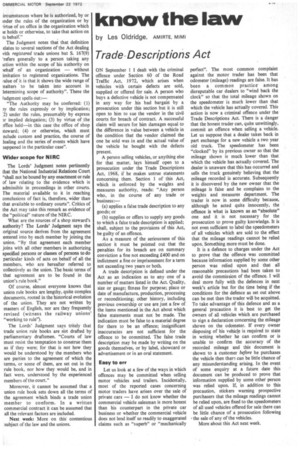know the law
Page 219

If you've noticed an error in this article please click here to report it so we can fix it.
by Les Oldridge, AMIRTE, MIMI
Trade-Descriptions Act
ON September 1 I dealt with the criminal offence under Section 60 of the Road Traffic Act, 1972, which arises when vehicles with certain defects are sold, supplied or offered for sale. A person who buys a defective vehicle is not compensated in any way for his bad bargain by a prosecution under this section but it is still open to him to sue the vendor in the civil courts for breach of contract. A successful claim will secure for him damages equal to the difference in value between a vehicle in the condition that the vendor claimed the one he sold was in and the actual value of the vehicle he bought with the defects present.
A person selling vehicles, or anything else for that matter, lays himself open to a prosecution under the Trade Descriptions Act, 1968, if he makes untrue statements concerning them. Section 1 of this Act,
which is enforced by the weights and measures authority, reads: "Any person who, in the course of any trade or business:—
(a) applies a false trade description to any goods; or (b) supplies or offers to supply any goods to which a false trade description is applied; shall, subject to the provisions of this Act, be guilty of an offence.
As a measure of the seriousness of this section it must be pointed out that the penalties for its breach are on summary conviction a fine not exceeding £400 and on indictment a fine or imprisonment for a term not exceeding two years or both.
A trade description is defined under the Act as an indication as to any one of a number of matters listed in the Act. Quality, size or gauge; fitness for purpose; place or date of manufacture, production, processing or reconditioning; other history, including previous ownership or use are just a few of the items mentioned in the Act about which false statements must not be made. The indication must be false to a material degree for there to be an offence; insignificant inaccuracies are not sufficient for the offence to be committed. The false trade description may be made by writing on the goods themselves, or by label, showcard or advertisement or in an oral statement.
Easy to err Let us look at a few of the ways in which offences may be committed when selling motor vehicles and trailers. Incidentally, most of the reported cases concerning motor traders have arisen over the sale of private cars — I do not know whether the commercial vehicle salesman is more honest than his counterpart in the private car business or whether the commercial vehicle does not lend itself so readily to exaggerated claims such as "superb" or "mechanically perfect". The most common complaint against the motor trader has been that odometer (mileage) readings are false. It has been a common practice among disreputable car dealers to "wind back the clock" so that the total mileage shown on the speedometer is much lower than that which the vehicle has actually covered. This action is now a criminal offence under the Trade Descriptions Act. There is a danger that the honest trader can, quite unwittingly, commit an offence when selling a vehicle. Let us suppose that a dealer takes back in part exchange for a new vehicle a two year old truck. The speedometer has been "clocked" by its previous owner so that the mileage shown is much lower than that which the vehicle has actually covered. The dealer is unaware that this has occurred and sells the truck genuinely believing that the mileage recorded is accurate. Subsequently it is discovered by the new owner that the mileage is false and he complains to the weights and measures department. The trader is now in some difficulty because, although he acted quite innocently, the offence is what is known as an "absolute" one and it is not necessary for the prosecution to prove guilty knowledge. It is not even sufficient to label the speedometers of all vehicles which are sold to the effect that the mileage readings cannot be relied upon. Something more must be done.
It is a defence to charges under the Act to prove that the offence was committed because information supplied by some other person was relied upon and that all reasonable precautions had been taken to avoid the commission of the offence. I will deal more fully with the defences in next week's article but for the time being if the conditions for the defence as set out above can be met then the trader will be acquitted. To take advantage of this defence and as a general precaution it is best to get the owners of all vehicles which are purchased to sign a declaration concerning the mileage shown on the odometer. If every owner disposing of his vehicle is required to state in writing whether he can confirm or is unable to confirm the accuracy of the recorded mileage and this document is shown to a customer before he purchases the vehicle then them can be little 'chance of any misunderstanding arising. In the event of some enquiry at a future date this document can be produced to prove that information supplied by some other person was relied upon. If, in addition to this precaution, stickers warning prospective purchasers that the mileage readings cannot be relied upon, are fixed to the speedometers of all used vehicles offered for sale there can be little chance of a prosecution following the sale of any of the vehicles.
More about this Act next week.
































































































































































































































































































































































































































































































































